All-terrain, modular Malaise trap for canopy-to-ground insect sampling
The freestanding SLAM trap (Sea, Land, and Air Malaise trap), a canopy trap variant, is a modular flight interception trap that operates on land, over water, or suspended in the air. It assembles quickly with shock-corded poles, reduces orientation constraints with cross baffles, and allows component-level replacement to minimize downtime. The design is patented.
Field Application: Long-term monitoring in the Azores, the “SLAM Project”, deploys standardized SLAM traps across multiple islands and forest types to track arthropod communities through time, using fixed service schedules for comparable catches.
Detailed Description
Traditional Malaise traps can be time-consuming to erect, require large open areas, and rely on external supports. The SLAM trap addresses these constraints with a self-supporting frame of shock-corded poles and clip points for rapid deployment across varied habitats. Cross baffles provide four-sided interception, sampling all quadrants around the trap and reducing sensitivity to wind direction or sun exposure during placement.
Major components—fabric body, collection head, and shock-corded poles—are individually replaceable to extend service life. The trap body is constructed from fine polyester fabric, providing uniform mesh for consistent interception and long-term field use. Deployment options include ground interception, canopy suspension, daisy-chaining for vertical stratification, and aquatic use with an optional flotation frame.
Ground Interception
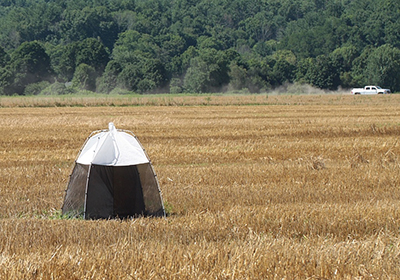 Ground Interception
Ground Interception
Canopy Suspension
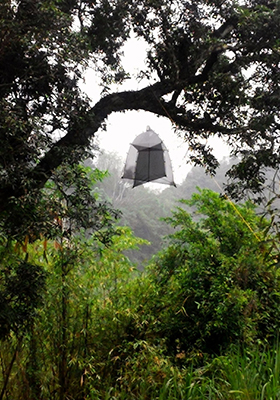 Canopy Suspension
Canopy Suspension
Vertical Stratification
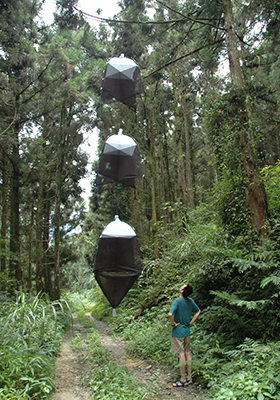 Vertical Stratification
Vertical Stratification
Aquatic Deployment
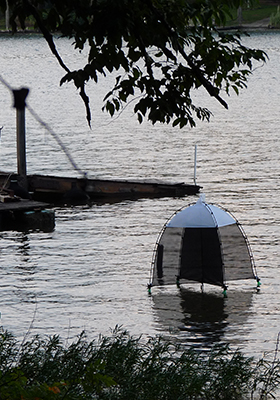 Aquatic Deployment
Aquatic Deployment
The SLAM trap can also function as a flight interception trap (FIT, or window trap). In this mode, insects that drop after impact (e.g., Coleoptera) are collected either with an optional bottom collector or with trays or ground cloths containing preservative placed beneath the intercept panel.
Window Trap Mode — Bottom Collector
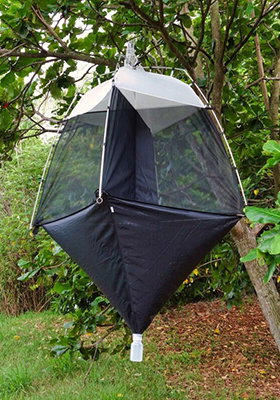 Window Trap — Bottom Collector
Window Trap — Bottom Collector
Window Trap Mode — Trays or Ground Cloths
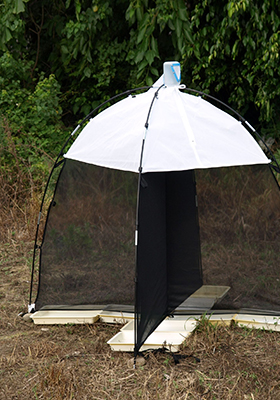 Window Trap — Trays or Ground Cloths
Window Trap — Trays or Ground Cloths
The inverted Y-shaped collection head is molded from solid polycarbonate for durability, UV resistance, and high transparency. Ventilation ports, closed by default, allow optional airflow; some studies report increased catch efficiency when airflow is enhanced. A removable moth excluder with 1 × 1 cm grid spacing limits entry of larger insects like Lepidoptera, helping reduce wing-scale contamination. Seat the head on the crossed supporting poles rather than the fabric body to maintain alignment.
Ventilation Ports
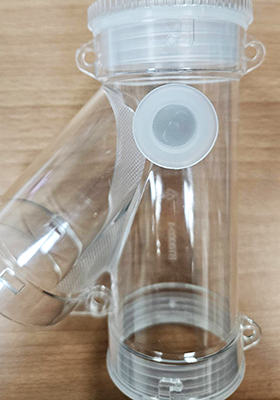 Ventilation Port — Closed
Ventilation Port — Closed
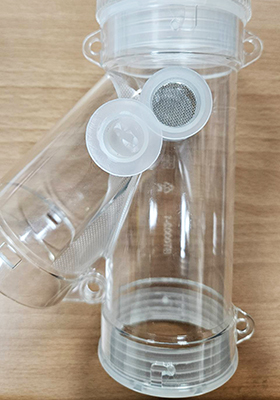 Ventilation Port — Open
Ventilation Port — Open
Removable Moth Excluder
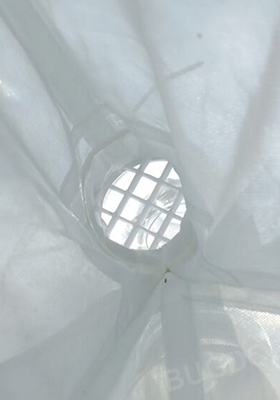 Removable Moth Excluder
Removable Moth Excluder
Collection Head Placement
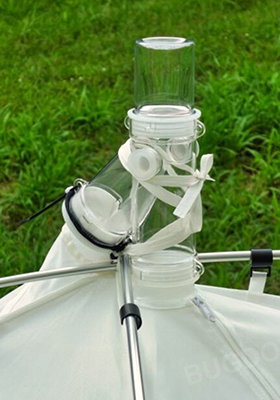 Collection Head Placement
Collection Head Placement
Functional Advantages
- Four-sided interception: Cross baffles collect from all directions, minimizing orientation bias and simplifying placement.
- Rapid setup: Shock-corded poles and clip-on assembly enable quick deployment without external supports; add guy ropes in wind.
- Multi-mode deployment: Operates on land, in the air, or over water with an optional flotation frame.
- Modular build: Replaceable fabric body, collection head, and poles minimize downtime and extend service life.
- Specimen management: Removable moth excluder limits entry of large insects and helps reduce wing-scale contamination.
Authenticity: The Standard SLAM Trap is an original, field-proven design cited in many peer-reviewed studies. Copies may exist, but only the BugDorm Standard SLAM Trap adheres to strict material, mesh, and dimensional specifications, ensuring repeatable results and cross-site comparability.
Field Notes
- Placement: Place along trails, forest edges, stream corridors, or canopy gaps.
- Collection head: Seat the head on the top junction of the supporting poles, not the fabric. Keep upright, tie securely, and recheck seating after bottle service or line re-tensioning.
- Ventilation ports: Open ports can improve airflow but may also admit rainwater, causing preservative dilution. They can likewise accelerate evaporation.
- Servicing: Service collection bottles on a regular schedule (e.g., weekly), adjusting for catch volume and weather. Re-tension guy ropes to maintain panel shape.
- Preservative and labels: Use ethanol or propylene glycol as appropriate for your analyses. Label bottles with trap ID, date/time, and preservative used.
- Hot or dry sites: Provide modest shade to reduce evaporation and top up preservative to prevent desiccation.
- Multiple traps: Space units 50–150 m apart to reduce spatial dependence. For canopy-to-ground sampling, daisy-chain SLAM traps on a suspension line over a high branch, and run a secondary rope through each trap's ground loops to keep the column aligned and stable.
Field Checklist
Before You Leave the Site
- Trap ID recorded (matches label set and notes)
- GPS coordinates captured and verified
- Photos taken (site, approach, trap context)
- Placement clear of branches/obstructions along insect flight paths
- Guy ropes secured; re-tensioned after setup
- Stakes seated (firm ground or alternative anchors used)
- Collection head seated on crossed poles (not fabric)
- Collection bottles installed and tightly closed
- Preservative type/volume confirmed; labels (ID, date/time, preservative)
- Moth excluder installed/removed as planned
- Ventilation ports set as planned (note setting in field log)
- Shade adequate for hot/dry sites (evaporation risk mitigated)
- Service schedule set (next visit date/time logged)
- Site hazards checked (public trails, livestock, flooding, tides, fire risk)
Canopy Suspension — Extras
- Suspension line anchored to two healthy trees; bark guards in place
- Trap column aligned; secondary guide rope run through ground loops
- Rope angles clear of branches; no chafe points at knots
- Drop zone clear; retrieval plan documented
- Height & compass orientation noted in field log
Aquatic Deployment — Extras
- Flotation frame secured; tether points checked
- Fetch/wind exposure acceptable; no collision hazards
- Bottle caps above splash line; rain cover if needed
- Water level & mooring slack recorded
- Recovery path & safety gear confirmed
ℹ︎ Disclaimer: Field Notes and Checklist provide practical guidance and examples. Actual procedures should be adapted to site conditions, study objectives, and institutional protocols. Users are responsible for safe deployment and compliance with local regulations.
Pack Contents
- 1 × Fabric Trap Body
- 2 × Shock-corded Poles (L309 cm)
- 1 × Collection Head (pre-installed)
- 3 × Collection Bottles (1 pre-installed)
alternative option
Nalgene™ 2105-0016 wide-mouth bottles (53 mm closure size; unavailable from this site) are compatible with the supplied bottles.
- 5 × Alloy Pin Stakes
- 1 × Carrying Bag
Prepare extra guy ropes and stakes as needed. Replacement parts are listed under the Parts tab.
Recent Literature Related to This Product Line (click to search more)
- Assessing baseline stress physiology as an integrator of environmental quality in a wild avian population. Madliger et al. (2015). Biological Conservation, 192, 409–417.
- Naturalization and control of Coptotermes gestroi in a Taiwanese forest. Chiu et al. (2016). Journal of Economic Entomology, 109(3), 1317–1325.
- Fly and wasp diversity responds to elements of the fire mosaic. Brown & York (2017). International Journal of Wildland Fire, 26(5), 434–443.
- Overview of Mitaraka survey: research frame, study site and field protocols. Touroult et al. (2018). Zoosystema, 40(1), 327–365.
- The pitfalls of biodiversity proxies across Amazonia. Ritter et al. (2019). Scientific Reports, 9(1), 1–13.
- Practical field ecology: a project guide. Wheater et al. (2020). John Wiley & Sons.
- Standards and best practices for monitoring and benchmarking insects. Montgomery et al. (2021). Frontiers in Ecology and Evolution, 8, 579193.
- Measuring the impact of conservation: the growing importance of monitoring fauna, flora and funga. Stephenson et al. (2022). Diversity, 14(10), 824.
- Differentiating effects of organic management, pesticide reduction, and landscape diversification for arthropod conservation in viticulture. Kaczmarek et al. (2023). Biodiversity and Conservation.
- Arthropod traits as proxies for abundance trends in the Azores. Oyarzabal et al. (2024). Ecography, 12, e07457.